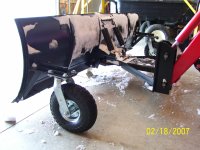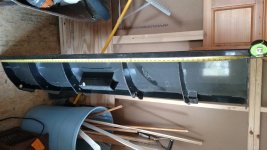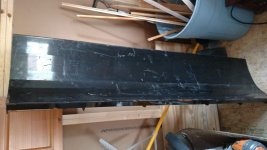Yes, I can use the bucket dump cylinders to tilt the plow, so that the cutting edge contacts the ground.
Normally, I keep it about 2" above that point.
There is a piece of 1.5" steel pipe with tabs welded on it, bolted on the cutting edge so it doesn't dig.
Using the loader in float, results in the arms contacting the ground. It worked out better to have the arms stationary, and let the plow float.
I quickly learned with v1.0, which had a rigid plow, and did not float, that I needed that, and the ability rotate some to follow the ground. The rotation was accomplished by having slop in the bolt that the plow pivots from side to side on. It doesn't take much slop, to give it the ability to move a couple of inches up, or down, on the outer edge.
The current v2.0 has the frame that mounts to the arms in the photo as in the photo above. But, the plow attaches to that frame, with pins like it does on a pick up truck. That allows it to hinge, so it can go up and down.
Most loader plows have a chain to restrict the amount the plow can go down. This plow doesn't weight 4000 lbs. So, I opted to put stops on the hinges instead. When the plow drops, there is a limit on the bottom how far, it can go.
My plow was derived from (2) Bolens tube frame, 42" garden tractor plows. They were from the 1960's and 70's. So, they are built well. And, not hard to find for sale, in the $35-$75 range.
I basically cut 15" of each side of one, and welded them on to the other. The pivot is built well. But, it needs to be beefed up for this application.
The original trip springs are heavy enough.
I always intended to add hydraulic angle to it. But, I found I only change the angle a couple of times when I plow. And, I could use the exercise. So, I decided to keep it simple for now.
The major advantage to a loader mounted plow, is the ability to push snow that is very high, from the top down. If I got 5' of snow, (sometimes I got drifts that high on lots of my driveway, before I learned how to use snow fence). I can set the blade 2' off the ground, and push the top half first, instead of trying to push it all at once. But, believe me I have had a mountain of snow moving in front of this thing. So, I normally just push it from the bottom.
If we get a lot of snow, and the piles get too high at the street, I can push the tops off, and lower them down to the height were my wife can see over them from her Civic.
I also often knock the top off the pile, the length of the drive, on the windward side, to keep the snow from filling in there, with drifts.
Yes, you can damage your loader, if you hit something. Which is always the case, no matter how you use it. But, that is why I like the Bolens plow. It is well built. But, not state plow truck, heavy duty. It can absorb some impact, and may break first, in the event of an accident.
The only damage I have had in 8 years, is the removable pin, that locks the angle can bend. And, that is by design.
No, I do not think it is a good idea to mount a plow directly on a GC loader bucket. The bottom of the bucket is not very thick. You would have to at least beef it up. The whole rig also gets too long.
I will go out and take some more detailed pictures today, and post them later on.



